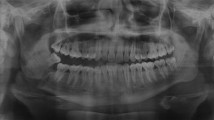Abstract
The introduction of 3-dimension systems for the treatment of mandibular fractures and continuity has offered certain advantages over other plating system. The present study was undertaken to compare 2.0 mm 3D titanium locking and non-locking miniplates in the management of mandibular fractures. A prospective study was conducted on 40 patients (20 in each group) of mandibular fractures treated by open reduction and internal fixation. Group A patients underwent osteosynthesis using 2.0 mm 3-D titanium locking miniplates while Group B used non-locking miniplates. Subsequent follow-up was assessed for pain, swelling, infection, paresthesia, malocclusion, mobility between fracture fragments and hardware failure in these patients. Functional occlusion was achieved postoperatively in all the patients. At 12 weeks of the time intervals, significant pain was observed in group B. At 1 week interval, 6 (30%) patients in both groups reported with swelling. Only one (10%) patient in each group had paresthesia which got resolved gradually over a period of 3 months. Infection was observed in only 2 (10%) patient in Group B at 3 months. Only 2 (10%) patient in Group B had hardware failure at 3 months interval. Statistically, there was no significant difference between both the groups at any time interval (p > 0.05). 3D titanium locking miniplates are effective in the treatment of mandibular fractures with lesser overall complications as compared to non-locking miniplates.




Similar content being viewed by others
References
Alpert B, Seligson D (1996) Removal of asymptomatic bone plates used for orthognathic surgery and facial fractures. J Oral Maxillofac Surg 54:618–621
Chritah A, Lazow SK, Berger JR (2005) Transoral 2 mm locking miniplate fixation of mandibular fractures plus 1 week of maxillomandibular fixation: a prospective study. J Oral Maxillofac Surg 63:1737–1741
Cawood JI (1985) Small Plate osteosynthesis of mandibular Fractures. Br J Oral Maxillofac Surg 23(2):77–91
Jain M, Sankar K (2012) Management of mandibular fractures using 3 ddimensional loking and standard titanium miniplates-A compararative preliminary report of 10 cases. J Craniomaxillo Facial Surg 40(8):e475–8
Champy M, Lodde JP, Schmitt R, Jaeger JH, Muster D (1978) Mandibular osteosynthesis by miniature screwed plate via a buccal approach. J Maxillofac Surg 6:14–21
Hayter JP, Cawood JI (1993) The functional case for miniplates in maxillofacial surgery. J Oral Maxillofac Surg 22:91–96
Ellis E III, Karas N (1992) Treatment of Mandibular Angle Fractures using two minidynamic compression Plates. J Oral Maxillofac Surg 50:958–963
Cordey J, Borgeaud M, Perren SM (2000) Force transfer between the plate and the bone: relative importance of the bending stiffness of the screw friction between plate and bone. Injury 31:21e–28
Cawood JI (1985) Small plate osteosynthesis of mandibular fractures. Br J Oral Maxillofac Surg 23(2):77–91
Smith WP (1991) Delayed miniplateosteosynthesis for mandibular fractures. Br J Oral Maxillofac Surg 29:73–76
Nakamura S, Takenoshita Y, Oka M (1994) Complications of miniplateosteosynthesis for mandibular fractures. J Oral Maxillofac Surg 52(3):233–238
Herford AS, Ellis E (1998) Use of a locking reconstruction bone plate/screw system for mandibular surgery. J Oral Maxillofac Surg 56(11):1261–1265
Ellis E III, Karas N (1992) Treatment of mandibular angle fractures using two minidynamic compression plates. J Oral Maxillofac Surg 50:958–963
Gabrielli MAC, Gabrielli MFR, Marcantonio E, Hochuli-Vieira E (2003) Fixation of Mandibular Fractures with 2.0-mm Miniplates: Review of 191 Cases. J Oral Maxillofac Surg 61:430–436
Mukerji R, Mukerji G, Mcgurk M (2006) Mandibular fractures: Historical perspective. Br J Oral Maxillofac Surg 44:222–228
Brown JS, Trotter M, Cliffe J, Ward-Booth RP, Williams ED (1989) The fate of miniplates in facial trauma and orthognathic surgery: A retrospective study. Br J Oral Maxillofac Surg 27:306–315
Author information
Authors and Affiliations
Corresponding author
Additional information
Publisher's Note
Springer Nature remains neutral with regard to jurisdictional claims in published maps and institutional affiliations.
Rights and permissions
About this article
Cite this article
Khan, M., Vishal, Kumar, A. et al. Comparative Evaluation of 3d Locking Versus Non-Locking Titanium Miniplates in the Treatment of Mandibular Fracture. Indian J Otolaryngol Head Neck Surg 72, 363–369 (2020). https://doi.org/10.1007/s12070-020-01884-z
Received:
Accepted:
Published:
Issue Date:
DOI: https://doi.org/10.1007/s12070-020-01884-z




